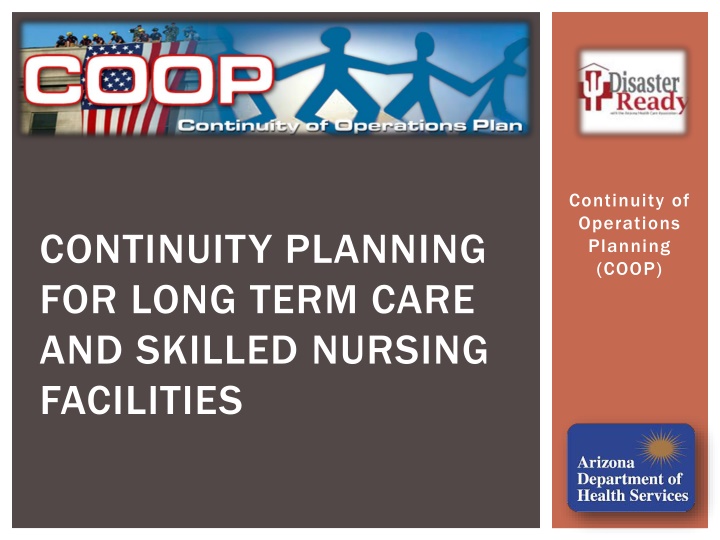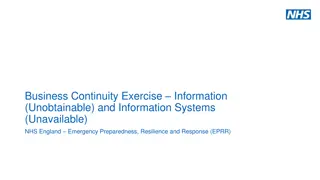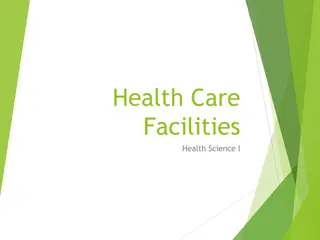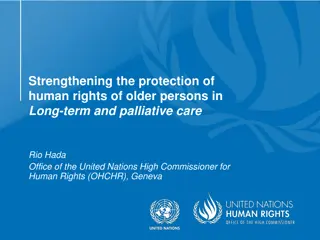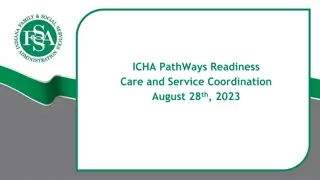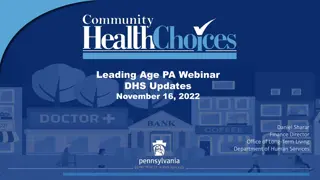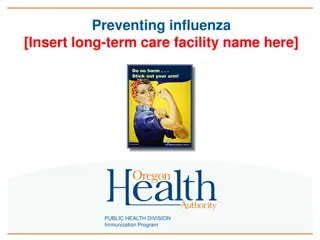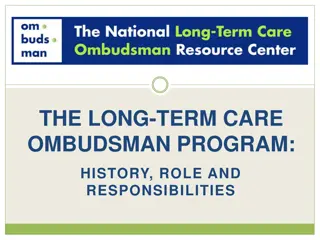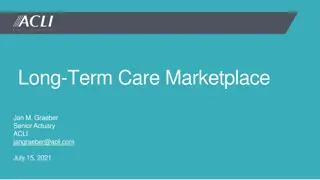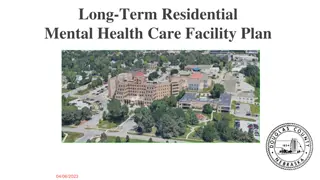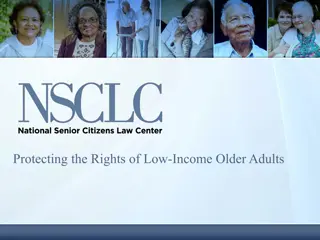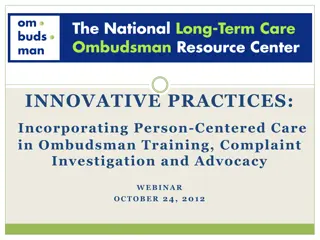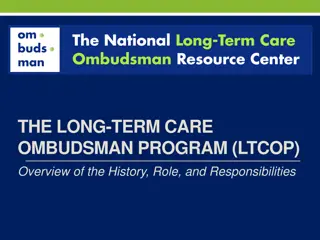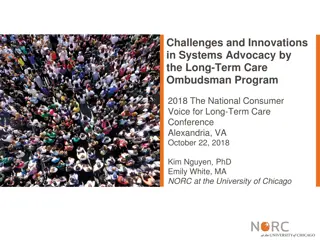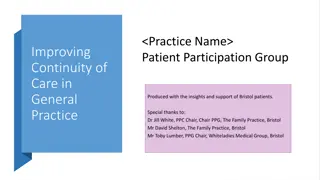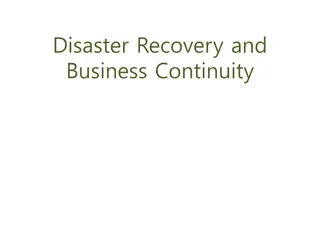Importance of Continuity Planning in Long-Term Care Facilities
Continuity of Operations Planning (COOP) is crucial for long-term care and skilled nursing facilities to ensure essential functions can continue during emergencies. This planning involves understanding key elements, utilizing templates, and developing strategies to maintain operations under adverse conditions. Failure to have a COOP can lead to devastating consequences, as highlighted by statistics showing the impact of disasters on businesses. Having a continuity plan in place is essential to safeguard residents, staff, investments, and meet financial obligations.
Download Presentation

Please find below an Image/Link to download the presentation.
The content on the website is provided AS IS for your information and personal use only. It may not be sold, licensed, or shared on other websites without obtaining consent from the author.If you encounter any issues during the download, it is possible that the publisher has removed the file from their server.
You are allowed to download the files provided on this website for personal or commercial use, subject to the condition that they are used lawfully. All files are the property of their respective owners.
The content on the website is provided AS IS for your information and personal use only. It may not be sold, licensed, or shared on other websites without obtaining consent from the author.
E N D
Presentation Transcript
Continuity of Operations Planning (COOP) CONTINUITY PLANNING FOR LONG TERM CARE AND SKILLED NURSING FACILITIES
DESIRED OUTCOMES OF TRAINING Participants will: Understand the importance of a Continuity of Operations Plan (COOP) Understand the key elements of a COOP Understand how to utilize the AHCA COOP template Be able to develop a COOP for their organization
WHAT IS CONTINUITY PLANNING? Continuity of Operations Planning/Plan (COOP): Ensuring the ability to continue essential functions within 12 hours and up to 30 days. Ensuring the organization s essential functions can continue to be performed during a wide range of emergencies, including localized acts of nature, accidents and technological or attack-related emergencies. -Federal Emergency Management Agency (FEMA)
COOP FOR LTC/SNF COOP is a roadmap for continuing operations under adverse conditions including: Loss or damage to a facility (e.g. fire, flood, chemical release, power failure and any other adverse event) Loss of staff and/or shifting staff to other responsibilities (pandemic flu, disease outbreak, emergency response) Loss of technical resources (hardware, software, applications) Loss of communication systems (phones, email, internet)
COOP FOR LTC/SNF COOP focuses on sustained operations of essential functions under all circumstances including: Nursing Services Admit, Transfer and Discharge Facility Management/Maintenance Information Management (EHR) Finance Payroll Dietary Services Pharmacy Family Communication
WHY DOES MY FACILITY NEED A CONTINUITY PLAN? FEMA estimates that 40% of small businesses do not recover after after a disaster Gartner Group reported that 43% of companies were immediately put out of business by a major loss of computer records, and another 51% permanently closed their doors within two years, leaving a mere 6% survival rate.
WHY DOES MY FACILITY NEED A CONTINUITY PLAN? To protect residents and staff and provide a safe environment of care To protect your investment (if you are an owner) To satisfy financial partners (investors, bankers and insurers) To protect your livelihood (if you are an employee) To meet DHS/CMS recommendations and other local, state and federal obligations To maintain and protect your reputation
PRIORITIZING ESSENTIAL FUNCTIONS Criteria for prioritizing functions Varies by organization Examples may include: Federal/state regulatory requirements Legal requirements Public health, safety and welfare Revenue/financial impact Public image/confidence Service to vulnerable populations Civil liberties
STRATEGIES FOR CONTINUING ESSENTIAL FUNCTIONS Contingency Planning/Alternate Strategies for Continuing Operations: Defined written procedures for key processes Paper forms (back-up to EHR) Off-site data storage and frequent backups Hard-copy contact and resource lists Redundant communication systems (portable radios, AzHAN, text messaging, HAM radios)
Tips for Writing the COOP CONTINUITY PLANNING FOR LONG TERM CARE AND SKILLED NURSING FACILITIES
USING THE TEMPLATE The COOP template includes a comprehensive introduction and specific instructions within each section It is important to follow the instructions and guidance in the template as well as use this presentation to help develop your COOP This presentation is designed to supplement the written guidance provided in the AHCA COOP template Slides in this presentation will correspond with specific pages in the template. Helpful tips are also included in ths presentation
COOP: PLAN V. PROGRAM A COOP plan contains: Prioritized lists of essential functions and processes Essential resources needed to support functions and processes Written contingency plans A COOP program includes: Ongoing staff training Annual exercises Improvement planning Implementation of contingency procedures/strategies Annual plan reviews and updates
GETTING STARTED (PAGE 5) Develop a planning team and review all sections of the template Determine which team members will be responsible for addressing checklist items under COOP PLAN DEVELOPMENT (page 5)
FACILITY PROFILE(PAGES 7-8) The Facility Profile provides a brief description of your facility, the residents you serve and their specific vulnerabilities including your facility s current level of readiness. ** Complete all required fields
HAZARD VULNERABILITY ANALYSIS (HVA) (PAGES 9-11) Some facilities may have already completed an HVA when they developed their Emergency Operations Plan (EOP). If so, you may not need to complete this section of the template and reference their completed HVA HVA template is available in Med Pass Manual HVA template is available on the Disaster Ready Disaster Ready website Consider having 1-2 people initially complete the HVA in the template and then review it with the planning team
ESSENTIAL FUNCTIONS (PAGES 12-13) Essential functions are those functions that cannot be interrupted for more than 12 hours and/or must be resumed within 30 days Identify your facility s essential and time-sensitive functions Determine what is minimally needed to care for your residents and maintain facility operations These are typically your day-to-day or broad functions Some of the broad categories of functions are listed on page 13 of the template
ESSENTIAL FUNCTIONS (PAGE 12-13) Utilize the Essential Programs/Services Priorities chart and assign each function a priority (A, B, C or D) Review this chart with your planning team and agree upon the designation (A, B, C or D) of each function This categorized information will help determine the organization s priorities during a crisis or emergency
RESTORATION PRIORITIES ESSENTIAL PROGRAMS/SERVICES RESTORATION PRIORITIES Priority Description Restoration Timeframe These programs or services must be restored A Critical Impact on Health and Safety, Business Operations or Client Services within 0-5 hours These programs or services must be restored B High Impact on Health and Safety, Business Operations or Client Services within 5-24 hours Moderate Impact on Health and Safety, Business Operations or Client These programs and services must be restored C Services within 24- 72 hours These programs or services can be restored within D Low Impact on Health and Safety, Business Operations or Client Services 72 hours to 2 weeks
ESSENTIAL PERSONNEL (PAGES 14-15) Identify essential personnel Ensure that you are selecting people who are familiar with the specific functions they will be responsible to support These staff members are critical to the continuation of key operations and services in the event of a COOP activation These staffer members may not necessarily be a supervisor/manager
CRITICAL RESOURCES (PAGES 16-18) HUMAN (CAPITAL) RESOURCES: Identify the number of staff who are prepared and trained to perform specific critical functions Human Resources should also have a list of Essential Functions (refer to pages 12 13 of the template)
CRITICAL RESOURCES (PAGES 16-18) VITAL (ESSENTIAL) RECORDS DATABASES EMERGENCY OPERATIONS PLANS (EOP) STAFF CONTACT INFORMATION ORDERS OF SUCCESSION DELEGATIONS OF AUTHORITY POLICY, PROCEDURES, SYSTEMS MANUALS LIST OF CREDIT CARD HOLDERS FOR EMERGENCY PURCHASING
CRITICAL RESOURCES (PAGES 16-18) MAPS AND BUILDING PLANS EMPLOYEE RECORDS RESIDENT HEALTH RECORDS TITLES, DEEDS AND CONTRACTS LICENSES AND LONG-TERM PERMITS FINANCIAL AND INSURANCE RECORDS
CRITICAL RESOURCES (PAGES 16-18) EQUIPMENT AND SUPPLIES Identify equipment and supplies needed to support essential functions
KEY VENDORS ~ SUPPLIERS (PAGES 19-20) DEVELOP A COMPLETE LIST OF VENDORS AND SUPPLIERS IDENTIFY ALTERNATE VENDORS AND SUPPLIERS AND DEVELOP A CONTACT LIST Confirm that primary and alternate vendors have their own COOP to help ensure their own services to support your operation
ALTERNATE FACILITIES/LOCATIONS (PAGES 21 22) Facilities should have identified an alternate location for client/resident care in their EOP Facilities should also identify an alternate site for business operations as part of their COOP An alternate site for business operations offers a solution for continuing business functions like finance, payroll, electronic health records, human resources, and other essential functions to help keep the business sustainable
EMERGENCY COMMUNICATIONS (PAGES 23-26) DEVELOP STRATEGIES FOR COMMUNICATION WITH THE FOLLOWING ENTITIES: Local emergency management agency Local emergency responders (police, fire, EMS) Facility staff Facility residents Residents families / Responsible parties Other local health care facilities Regulatory/licensing agencies Suppliers/vendors Corporate contacts Media
EMERGENCY COMMUNICATIONS (PAGES 23-26) ALERT AND NOTIFICATION PROCEDURES: Establish procedures to notify staff about operational status during an emergency Directions on reporting to work or alternate location(s) Identify those within the operation that will be responsible for staff notification Staff contact rosters should be attached to the COOP and updated regularly Maintain hard copies of COOP in remote locations
KEY CONTACTS (PAGES 27-28) Key contact information: Resident relatives / Responsible parties Vendors Regulatory agencies Contact lists should include all contacts identified under emergency communications
INFORMATION TECHNOLOGY (PAGES 29-34) The facility s IT department or person responsible for information management should complete this section of the template: Includes a complete inventory of technology IT security Essential records Databases Hardware Software
FINALIZING THE COOP Have more than one team member review the completed plan Route the final plan to leadership for final review, sign off and plan adoption Keep this document and all of the associated documents backed up and accessible Review your COOP annually Review when operational changes occur
RESOURCES/REFERENCES National Fire Protection Agency 1600: Standard on National Fire Protection Agency 1600: Standard on Disaster/Emergency Management and Business Disaster/Emergency Management and Business Continuity Programs Continuity Programs, 2013 , 2013 Edition Proposed Rule, Medicare and Medicaid Programs, Proposed Rule, Medicare and Medicaid Programs, Emergency Preparedness Requirements for Medicare Emergency Preparedness Requirements for Medicare and Medicaid Participating Providers and Suppliers, and Medicaid Participating Providers and Suppliers, Center for Medicare and Medicaid Services, Center for Medicare and Medicaid Services, December 2013 December 2013 https://www.federalregister.gov/articles/2013/12/2 7/2013-30724/medicare-and-medicaid-programs- emergency-preparedness-requirements-for-medicare- and-medicaid Edition
RESOURCES/REFERENCES Emergency Preparedness Checklist: Recommended Tool Emergency Preparedness Checklist: Recommended Tool for Effective Healthcare Facility Planning for Effective Healthcare Facility Planning, December 2013, United States Department of Health and Human 2013, United States Department of Health and Human Services, Centers for Medicare and Medicaid Services, Services, Centers for Medicare and Medicaid Services, Survey and Certification Survey and Certification http://www.cms.gov/Medicare/Provider-Enrollment-and- certification/SurveyCertEmergPrep/Downloads/SandC_E PChecklist_Provider.pdf AHCA, AZ Skilled Nursing Facilities: 2012 Disaster AHCA, AZ Skilled Nursing Facilities: 2012 Disaster Ready Gap Assessment Overview and Ready Gap Assessment Overview and Summary California Association of Healthcare Facilities, Disaster California Association of Healthcare Facilities, Disaster Preparedness Program, Continuity of Operations Plan Preparedness Program, Continuity of Operations Plan Template for Long Term Care Facilities Template for Long Term Care Facilities http://www.calhospitalprepare.org/sites/main/files/file- attachments/coop_template.pdf , December Summary
Continuity of Operations Planning (COOP) CONTINUITY PLANNING FOR LONG TERM CARE AND SKILLED NURSING FACILITIES
